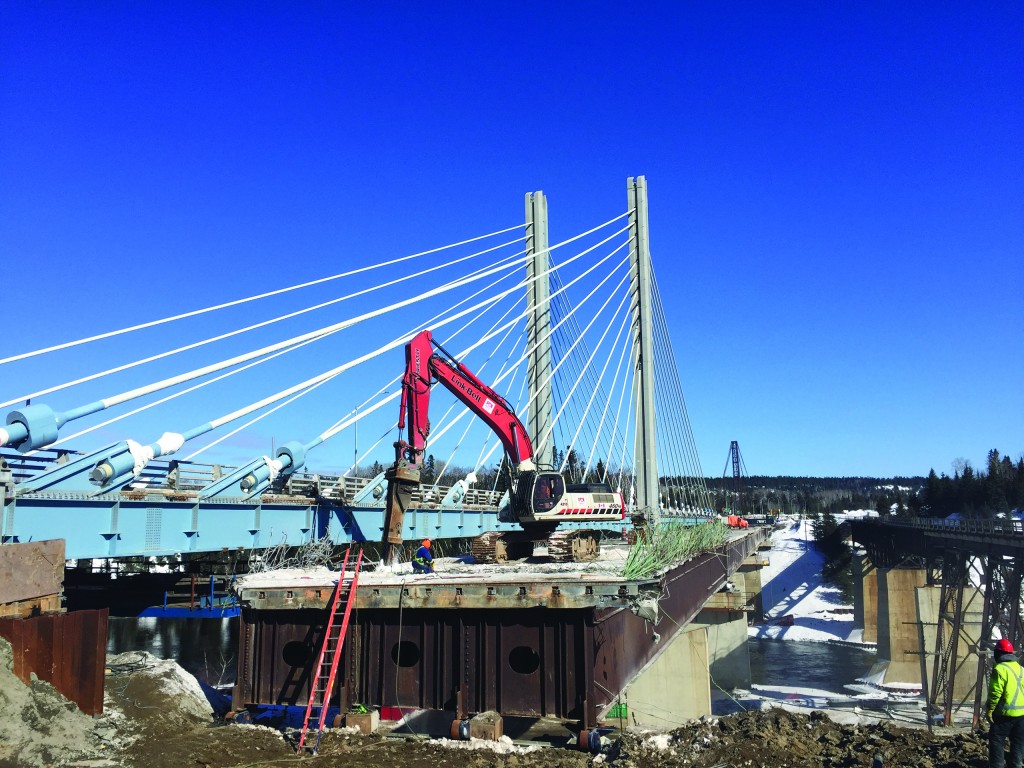World Demolition Award Winner

Priestly Demolition Inc. (PDI), based in King, Ontario just north of Toronto, won two prestigious awards at the 2016 World Demolition Awards in Miami, Florida. PDI submitted applications for seven of the eleven award categories and were shortlisted for six, a major accomplishment in itself considering that this was their first time as an entrant and they were up against 98 companies from 19 countries.
"Going down to the awards as a first time entry into the Demolition Awards, we didn't know what to expect," said Ryan Priestly, PDI President. "We were competing against the whole world in demolition projects, including Japan, [the] U.S., Australia, Italy and England - to name a few - and their extensive projects."
Ryan Priestly manages the field operations and equipment for PDI. Even when he was very young, he wanted to be out on a machine and working with his dad Vic, who founded Vic Priestly Contracting Limited in 1971. In 1993, Priestly Demolition Inc. was incorporated as a unionized company with 10 employees, many of whom continue to work with the company today.
Today, Ryan's knowledge and expertise are the driving force behind PDI's innovations in demolition techniques and their growth to become one of the largest and most respected demolition companies in Canada.
This showed up in the assessment by the judges of PDI's creative solution for the demolition of the Nipigon Bridge in northern Ontario. They said it showed "outstanding innovation" and that "Priestley deserves this year's ‘best of the best'."
Ryan Priestly said: "For the Nipigon Bridge project we submitted, we were able to win over the judges with our innovative methods from safety to schedule, no matter the weather, winning us the Civil Demolition Award. This was very exciting in itself but to come out as the company that won the highest recognition of World Demolition Award was amazing. It takes teamwork to win such a prestigious award and that is the one thing that makes this company great."
The Nipigon Bridge project involved the removal of an old two-lane, 810-foot long bridge with a 270-foot span 100 feet above the Nipigon River in the middle of winter with a tight deadline. The bridge is at the top of Lake Superior, east of Thunder Bay, and is a vital crossing, the only highway link between eastern and western Canada.
Eventually the bridge, the narrowest section of the Trans-Canada Highway, became a bottleneck, sometimes bringing traffic to a standstill.
To solve the problem, a $100-million project was developed to construct twin cable-stayed bridges, each with two lanes. Half the bridge was completed in late 2015 and traffic was switched from the old bridge, which could now be demolished.
How to demolish it proved to be a challenge. The design of the old bridge made it very difficult to take apart, using a barge under the bridge was costly, and with it being situated between the new bridge and a railroad bridge, there wasn't room to use a crane.
The Nipigon River also posed an environmental concern and everyone was watching, including the Department of Fisheries and Oceans and the Ministry of Natural Resources, so PDI had to develop an innovative solution: they would hydraulically lift the bridge, place rollers under the girders and then roll the bridge off to demolish it on the ground.
To help with this plan, PDI hired Western Mechanical Electrical Millwright Services. Western's engineering experience and use of specialized equipment has helped them become a global contractor offering a range of services which include hydraulic expertise and heavy lifting.
The crew cut access holes in the deck of the bridge so that Western Mechanical could get their jacks and rollers in place.
An aluminum platform was installed underneath the bridge to catch debris. This walking platform would be moved along as the deck was removed.
Next, the crew removed an overhang on the western section, and an overhang and decking on the eastern section.
The bridge was jacked up to place the 16-inch-diameter rollers on top of the piers underneath the steel girders. A total of 48 rollers were used and each roller could hold 100 tons. Eight of the rollers had hydraulic gearboxes attached to them; each one of those hydraulic drives generated 10 tons of force.
PDI and Western Mechanical installed a king post with a cable system to hold up one end of the bridge. This was an enormous balancing act, with the king post and cables supporting a moving cantilevered bridge. Every kilogram on both ends was carefully calculated. Any wrong numbers could send the bridge crashing into the river below.
In early 2016, the deck was completely removed east of the king post, and to the west the overhang had been cleared away. By March 2, with the rollers in place, PDI and Western Mechanical were finally ready to get the bridge rolling. The temperature had dropped to -40 degrees C, but work continued.
The bridge rolled the first 45-foot section fairly quickly onto the embankment, where a crew used torches to cut it off. Then one excavator lifted a part of the section while another excavator demolished the concrete decking.
They removed more deck, cut girders and moved them out of the way, and then rolled the bridge another 50 feet.
Most of the decking was left in place to act as a counterweight, along with the weight of a Link Belt 460 excavator which would remain on the deck. The excavator would keep the west end of the bridge weighted down and be constantly removing more decking as the bridge was rolled.
At the end of the first day, they had removed 160 feet of bridge, right up to the first tower. The next day would be even bigger as they had to remove 270 feet of bridge that spanned from the first to the second pier.
When the portion of the bridge supported by the king post was ready to roll completely clear of the supporting piers, special preparations had to be undertaken as the full weight of the east portion of the bridge would only be supported by cables and balanced by the counterweight. The first step was to tighten the cables on the king post to hold the excess weight and to prevent sagging, which would have stopped movement and may have resulted in the bridge failing.
The crew worked through the weekend, removing 50-foot sections at a time, and finally taking down the king post.
The final section resting on the last pier was not over a sensitive river bed so a different method was used to bring it down to the ground. An excavator carefully chipped away at the top of the concrete pier so that the end of the section resting on the pier was gradually lowered. As the end of the section got near the ground, it was allowed to slip off the shortened pier and fall to the ground. All that remained was to cut up the steel and remove it and the broken concrete for recycling.
One hundred percent of the steel and concrete was recycled.


